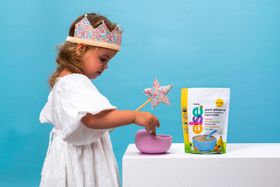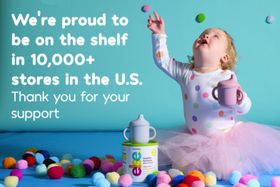Is Ready to Feed Formula Easier to Digest? 7 Tips for Choosing An Infant Formula
Published May 27, 2024

Parents often wonder: Is ready to feed formula easier to digest for infants compared to powdered formulas? Digestion is critical for your baby’s comfort and nutrition, and ready to feed formula may offer advantages in digestibility alongside sterility and convenience.
This article delves into these aspects, providing insight to help you make the best choice for your little one.
Key Takeaways
Ready to feed infant formula offers convenience and sterility, making it a safe option for newborns, especially those who are premature or have compromised immune systems.
Factors like protein type and composition, the balance of fats and carbohydrates, and specialized formulas play crucial roles in the digestibility of infant formulas for sensitive tummies.
When transitioning between different formula types, a gradual mix is recommended, and parents should consult healthcare professionals for personalized advice and monitor the baby’s digestive response.
Understanding Ready to Feed Formula
When it comes to infant nutrition, ready to feed formula shines as a beacon of convenience for sleep-deprived parents. It’s the formula that says “Skip the scoop, I’ve got you covered.” Unlike powdered formulas, which demand a mixologist’s precision, ready to feed formula is just as the name implies—open and serve. But is this liquid gold just about saving time, or is there more to the story?
Indeed, the plot thickens when we consider the sterility and consistency of ready to feed formulas. These liquid nourishments offer a level of safety and uniform nutrient delivery that powdered formulas can find challenging to match. No need to fret over the quality of tap water or the accuracy of measurements. With ready to feed, you’re giving your baby a consistent dose of nutrition with every bottle.
Another common alternative is cow's milk-based formula, which is suitable for healthy full-term infants. It is fortified with essential minerals and vitamins, providing nutritional benefits that whole cow's milk cannot offer before the age of one.
The Sterility of Ready to Feed Formula
Sterility is the watchword when it comes to newborns and infants with special health considerations, and ready to feed formula rises to the occasion. This type of formula is a knight in shining armor for babies who are premature or have immune systems that aren’t fully developed, providing a safer feeding option free from the risks of bacterial contamination. It’s a relief for parents who, above all, want to ensure their baby’s safety.
The sterile nature of ready to feed formula is particularly beneficial for infants younger than two months old, as well as those who were born ahead of schedule or with immunity concerns. It’s a trusted ally in their early, vulnerable days, guarding against infections and giving babies a fighting chance to thrive.
Convenience Factor: No Mixing Required
Who knew that becoming a parent would also mean getting a crash course in food preparation? With powdered formula, every feed turns into a mini science experiment—measuring, mixing, and making sure everything’s just right. But with ready to feed formula, it’s as simple as pour and serve. This is the kind of convenience that can make the difference during a midnight feeding or when you’re out and about with a hungry baby.
Moreover, the packaging of ready to feed formulas is designed for the parent on the move. Portable, easy to open, and no fuss involved, they are a godsend for those times when you need a quick, reliable feeding solution. Forget the hunt for clean water or the worry of incorrect ratios; with ready to use formula, your baby gets the right nutrition every time, anywhere.
Nutrient Absorption in Ready to Feed vs. Powdered Formulas
The quest for the perfect infant formula isn’t just about convenience; it’s also about nutrition. Ready to feed and powdered formulas both aim to provide the essential nutrients babies need, but the journey they take through your little one’s digestive system can differ. Organic formulas, in particular, focus on mimicking the fatty acid profile of breast milk—one of the many aspects that play into nutrient absorption.
The fatty composition of organic infant formulas is influenced by the diets of the animals that provide the milk. When the curtain is pulled back, we find that the quality of these fats can significantly affect the formula’s overall quality, potentially impacting how well your baby can absorb and utilize these vital nutrients.
Digestibility Factors in Infant Formula
As any seasoned parent knows, not all formulas are created equal when it comes to digestibility. Some infants might thrive on one type of formula, while others could experience discomfort and feeding intolerance.
So, what’s the secret ingredient for a formula that’s gentle on a baby’s delicate digestive system? It turns out that factors like protein content, fat and carbohydrate composition, and specialized formulas for sensitive stomachs are the key players in this puzzle.
Interestingly, studies have pointed out that infants fed with ready to feed formula may have a growth pattern more akin to their breastfed counterparts and a decreased likelihood of becoming overweight compared to those on powdered formulas. Yet, this isn’t a one-size-fits-all solution. Some research, particularly in preterm infants, indicates an uptick in feeding intolerance with ready to feed formulas, reminding us that each little tummy is unique.
Protein Content and Type
Let’s talk protein, the building blocks of growth. Not all proteins are created equal, especially when it comes to tiny tummies. Casein, a common component in cow’s milk protein, is tougher for babies to digest compared to whey protein. When choosing an infant formula, considering whether the protein is hydrolyzed or contains Casein A2 is crucial, as these factors greatly influence gastrointestinal tolerability.
For the little ones who throw a curveball with milk or soy allergies, hydrolyzed formulas are the MVPs. These cow’s milk based formulas, as well as soy based formulas:
contain cow’s milk proteins that have been broken down into smaller parts
are more digestible and less likely to trigger an allergic reaction
are a game-changer for babies who need a formula that’s not only easy to digest but also safe from allergens.
For babies with cow's milk protein allergy, extensively hydrolyzed protein and amino acid-based formulas are recommended. These formulas contain proteins that are broken down into small protein pieces or amino acids, making them suitable for babies with allergies. Although they are usually more expensive, they may be covered by insurance.
Fats and Carbohydrates in Formula
Diving deeper into the contents of infant formula, we find fats and carbohydrates playing a significant role in how well a baby can digest and absorb their food. The lion’s share of lipid intake from formulas comes in the form of triglycerides, which along with a minor contribution from phospholipids and cholesterol, make up more than 90% of an infant’s fat consumption.
Carbohydrates, mainly provided by lactose in both infant formulas and human milk, serve as the primary enteral source of glucose for babies. Moreover, lipids in formulas are a major source of calories, accounting for about 40-50% of total energy intake. When it comes to essential fatty acids, like linoleic and alpha-linolenic acid, they are indispensable in infant formulas for proper nutrition and development, underscoring the importance of the right fat and carbohydrate balance for an infant’s health.
Specialized Formulas for Sensitive Tummies
But what about the babies who seem to have a bone to pick with most formulas? Enter specialized formulas, the superheroes for sensitive tummies. Whether it’s hydrolyzed protein formulas like Enfamil Nutramigen or amino acid-based options like Neocate, these special concoctions are tailored to ease digestion and provide comfort from colic or constipation.
For families who are vegan, soy formulas can be a potential alternative. While experts do not typically recommend soy-based formula, it may be an option for vegan families, with the recommendation to consult a pediatrician.
The signs that might prompt a switch to these specialized formulas include troubling symptoms like diarrhea, vomiting, and unexplained pain. However, before making the leap to a special formula, it’s essential to get a pediatrician’s input, ensuring that the symptoms aren’t misinterpreted and that the new dietary direction is indeed beneficial for your baby.
1. Transitioning Between Formula Types
Suppose you’ve decided to make a switch in your baby’s formula due to intolerance, preference, or a doctor’s recommendation. In that case, the transition should be as smooth as your baby’s bottom. Often, the best approach is to start with a blend that’s mostly the old formula, gradually tipping the scales in favor of the new one. But this isn’t just about mixing two liquids; it’s about carefully observing how your baby reacts to the change.
One can opt for a one-step or slow transition method, and the choice largely depends on your baby’s specific needs and the type of formula being introduced. If the transition seems rocky, mixing the formulas over a period and seeking a doctor’s guidance is the best course of action. Consistency is key, so if you’re switching from ready-made to powdered formula, maintaining the same base, such as cow’s milk-based or partially hydrolyzed, is advisable.
2. When to Consider Changing Formulas
But when should you consider changing formulas in the first place? If your baby is giving you signals like excessive spit-up, slow weight gain, or severe constipation, these could be distress flares saying it’s time for a formula change. Pediatricians might suggest a new formula if your baby is showing signs of intolerance or sensitivity to their current one.
For infants with particular dietary needs or medical conditions, specialized formulas offer a tailored solution that’s easier on the digestive system. However, if your baby seems to be struggling with the new formula, a gradual mix with the old one can ease them into the transition. Remember, a baby’s health is too important to rely on guesswork, so always involve a pediatrician before making a switch.
3. Monitoring Baby's Digestive Response
As you navigate the seas of formula transition, keep a watchful eye on your baby’s bowel movements and other signs of tolerance. Changes in stool color and consistency can be part of the normal adjustment process due to the different nutrient contents in formulas. It’s like a detective game, where each clue helps you piece together how well your baby is adapting to the new formula.
Some babies might experience gassiness or react to taste differences when switching formulas. These are the side effects to look out for. Doctors typically recommend allowing a trial period of 3 to 5 days to gauge a formula’s suitability for your baby. Always be on the lookout for reactions that stray from the norm and don’t hesitate to seek medical advice when in doubt.
4. Consulting Healthcare Professionals
When it comes to your baby’s nutrition, consulting healthcare professionals isn’t just a good idea—it’s essential. They can provide personalized advice tailored to your baby’s unique needs, especially when dealing with food allergies or digestive issues. It’s never advisable to switch a baby from specialty or hypoallergenic formula to a standard one without a pediatrician’s green light.
For families who find the cost of formula daunting, healthcare professionals can point you toward local resources and assistance programs. They’re your allies in disease control, ensuring your baby’s diet supports their growth and health at every stage.
5. Practical Considerations for Parents
Choosing between ready to feed and powdered formulas isn’t just about what’s best for the baby; it’s also about what works for the family. Parents weigh personal preferences, which include health needs, lifestyle, and even the ticking clock of daily life. Time commitment for preparation and the baby’s risk factors are practical aspects that influence this decision.
But let’s not forget the elephant in the room: budget. The choice between formula types often comes down to what parents can afford. Whether the priority is convenience, cost-effectiveness, or something in between, it’s a balancing act between the needs of the baby and the realities of family life.
6. Cost Comparison: Ready to Feed vs. Powdered Formula
When it comes to cost, ready to feed formula takes the cake for convenience but can also take a bigger bite out of your budget. It’s the most expensive type of formula on the market, and once opened, it’s a race against time to use it before it spoils. However, for parents who value time over money, the convenience might be worth the extra pennies.
But don’t let sticker shock close the book on your formula options. Savvy shopping can uncover deals that lighten the financial load of baby formula. Comparing prices and hunting for discounts can help parents find a balance between cost and convenience.
Storage and Preparation Differences
Beyond the price tag, storage and preparation play leading roles in the formula decision-making process. Powder formula offers a mix-it-yourself adventure, with each scoop paired with two ounces of water, while liquid concentrate demands an equal mix of water and concentrate. Once prepared, these mix powder formula concoctions have a limited shelf life in the fridge—up to 24 hours for powdered and 48 hours for mixed liquid formulas.
Ready-to-feed formula, on the other hand, boasts shelf stability unopened at room temperature and a 48-hour window once opened and refrigerated. Powdered formulas, once they’ve made their debut from the canister, need to be used within 30 days. These differences can sway parents towards one option or another, depending on their storage capabilities and lifestyle needs.
7. Environmental Impact of Formula Choices
While parents’ primary concern is often their baby’s health and nutrition, the environmental impact of formula choices is also a factor that weighs on the minds of eco-conscious caregivers. Ready-to-feed formulas tend to leave a larger carbon footprint, primarily due to their packaging. Each serving comes in its own container, leading to a higher accumulation of waste compared to the bulk packaging of powdered formulas.
This disparity in packaging suggests that parents who prioritize environmental sustainability may lean towards powdered formulas. While both formula types serve the same purpose, the choice could come down to which aligns with the family’s values regarding environmental stewardship. It’s a decision that extends beyond the kitchen counter and into the wider world that our children will inherit.
Real Parent Experiences with Formula Digestibility
Real-life stories from parents can provide a wealth of insight into the world of infant feeding. Digestibility is a common theme in these narratives, with experiences varying as widely as baby’s favorite onesie patterns. Some parents sing praises for ready to feed formula, crediting it for easing their infants’ digestive woes, while others recount challenges that persist despite its promises.
It’s important to remember that while most digestive issues, like reflux, may resolve by the time a baby celebrates their first birthday, the journey there can be filled with trial and error. Parents seeking the perfect formula often find solace in the shared experiences of others, finding clues and comfort in the stories of those who’ve navigated similar paths with anti reflux formulas.
Positive Digestive Outcomes with Ready to Feed
For some families, the switch to ready to feed formula has been a game-changer. Anecdotal evidence from parents points to noticeable improvements in their infants’ digestion, with a decrease in gassiness and fussiness, and even better stool consistency. The consistent quality of ready to feed formulas, free from the variability of mixing errors, is often credited for these positive outcomes.
Compared to whole cow's milk, cow's milk based formula is specifically modified to meet the nutritional needs of infants, providing essential nutrients and being easier to digest.
Moreover, alternatives like goat milk formula and cow’s milk based formula, which is rich in A2 beta-casein proteins, have shown to be gentler on sensitive stomachs and closer to the composition of breast milk. Parents who’ve chosen this path report that their infants’ stool frequency and consistency bear a resemblance to that of breastfed infants, highlighting the potential benefits of exploring different formula options.
Challenges Some Infants Face with Ready to Feed
However, the story isn’t all roses. Some infants continue to face colic, reflux, and other digestive issues despite the switch to ready to feed formulas. In certain cases, symptoms like gas troubles or hard stools persist, underscoring the reality that individual variability plays a significant role in how infants respond to different formula types.
This variability is a stark reminder that one formula does not fit all. Factors like an immature digestive system, physical conditions like tongue-tie, or ingredients like palm oil in certain formulas can all contribute to feeding challenges. These instances highlight the importance of personalized care and the need for ongoing observation and adaptation to find the right fit for each unique baby.
Summary
In conclusion, the journey to finding the right infant formula is paved with considerations of digestibility, convenience, cost, and environmental impact. Ready to feed formula offers unmatched sterility and ease of use, but it’s not without its higher price tag and environmental costs. Protein type, fats, and carbohydrates in formula are pivotal for digestion, and specialized formulas can be lifesavers for sensitive tummies. Transitioning between formulas requires vigilance and professional guidance, and while some parents report success with ready to feed, others face ongoing challenges.
Ultimately, the best choice is informed by individual needs, expert advice, and the willingness to adapt. May this guide serve as a compass in your quest to nourish your baby with love and the right nutrition.
Frequently Asked Questions
Is ready to feed formula better than powdered for newborns?
Yes, ready to feed formula is a safer option for newborns, particularly for premature or immunocompromised infants, as it is sterile and reduces the risk of bacterial contamination.
Can I switch from powdered to ready to feed formula without consulting a doctor?
It's important to maintain the same base when switching formula, and consulting with a healthcare professional is essential, especially if your baby has special health needs or you're transitioning from a specialized formula.
How do I know if my baby needs a specialized formula?
If your baby is showing signs of intolerance or sensitivity, such as excessive spit-up or slow weight gain, it may be time to consider a specialized formula, and consulting with a pediatrician is essential for proper diagnosis and treatment.
What are the environmental impacts of choosing ready to feed formula?
Choosing ready to feed formula can have a higher environmental impact due to more packaging waste, so opting for powdered formulas may be a more environmentally friendly choice.
Are there cost-effective ways to purchase ready to feed formula?
Yes, you can save money on ready to feed formula by comparing prices at different retailers, buying in bulk, and using discounts or coupons. Shopping around for the best deals can help reduce costs.
The content and advice provided in this article is for informational purposes only and is not a substitute for medical diagnosis, treatment, advice for specific medical conditions. Always consult a pediatrician to understand the individual needs of your child. The article expresses the views of the brand editor.








